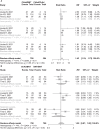Immunogenicity and safety of heterologous versus homologous prime-boost schedules with an adenoviral vectored and mRNA COVID-19 vaccine: a systematic review
- PMID: 35562753
- PMCID: PMC9100319
- DOI: 10.1186/s40249-022-00977-x
Immunogenicity and safety of heterologous versus homologous prime-boost schedules with an adenoviral vectored and mRNA COVID-19 vaccine: a systematic review
Abstract
Background: Heterologous prime-boost with ChAdOx1 nCoV-19 vector vaccine (ChAd) and a messenger RNA vaccine (BNT or mRNA-1273) has been widely facilitating mass coronavirus disease 2019 (COVID-19) immunisation. This review aimed to synthesize immunogenicity and reactogenicity of heterologous immunisations with ChAd and BNT (mRNA-1273) vaccine compared with homologous ChAd or BNT (mRNA-1273) immunisation.
Methods: PubMed, Web of Science, and Embase databases were searched from inception to March 7, 2022. Immunogenicity involving serum antibodies against different SAS-CoV-2 fragments, neutralizing antibody, or spike-specific T cells response were compared. Any, local and systemic reactions were pooled by meta-analysis for comparison.
Results: Of 14,571 records identified, 13 studies (3024 participants) were included for analysis. Compared with homologous BNT/BNT vaccination, heterologous ChAd/BNT schedule probably induced noninferior anti-spike protein while higher neutralizing antibody and better T cells response. Heterologous ChAd/BNT (mRNA-1273) immunisation induced superior anti-spike protein and higher neutralizing antibody and better T cells response compared with homologous ChAd/ChAd vaccination. Heterologous ChAd/BNT (mRNA-1273) had similar risk of any reaction (RR = 1.30, 95% CI: 0.86-1.96) while higher risk of local reactions (RR = 1.65, 95% CI: 1.27-2.15) and systemic reactions (RR = 1.49, 95% CI: 1.17-1.90) compared with homologous ChAd/ChAd vaccination. There was a higher risk of local reactions (RR = 1.16, 95% CI: 1.03-1.31) in heterologous ChAd/BNT (mRNA-1273) vaccination compare with homologous BNT/BNT but a similar risk of any reaction (RR = 1.03, 95% CI: 0.79-1.34) and systemic reactions (RR = 0.89, 95% CI: 0.60-1.30).
Conclusions: Heterologous ChAd/BNT schedule induced at least comparable immunogenicity compared with homologous BNT/BNT and better immunogenicity compared with homologous ChAd/ChAd vaccination. The synthetical evidence supported the general application of heterologous prime-boost vaccination using ChAd and BNT COVID-19 vaccines.
Keywords: COVID-19; Heterologous vaccination; Homologous vaccination; Immunogenicity; Safety.
© 2022. The Author(s).
Conflict of interest statement
Jingjing Lv, Hu Wu, Junjie Xu, and Jiaye Liu declare that they have no conflict of interest.
Figures


Similar articles
-
Safety and immunogenicity of heterologous versus homologous prime-boost schedules with an adenoviral vectored and mRNA COVID-19 vaccine (Com-COV): a single-blind, randomised, non-inferiority trial.Lancet. 2021 Sep 4;398(10303):856-869. doi: 10.1016/S0140-6736(21)01694-9. Epub 2021 Aug 6. Lancet. 2021. PMID: 34370971 Free PMC article. Clinical Trial.
-
Immunogenicity, safety, and reactogenicity of heterologous COVID-19 primary vaccination incorporating mRNA, viral-vector, and protein-adjuvant vaccines in the UK (Com-COV2): a single-blind, randomised, phase 2, non-inferiority trial.Lancet. 2022 Jan 1;399(10319):36-49. doi: 10.1016/S0140-6736(21)02718-5. Epub 2021 Dec 6. Lancet. 2022. PMID: 34883053 Free PMC article. Clinical Trial.
-
Immunogenicity and reactogenicity of heterologous immunization schedules with COVID-19 vaccines: a systematic review and network meta-analysis.Chin Med J (Engl). 2023 Jan 5;136(1):24-33. doi: 10.1097/CM9.0000000000002567. Chin Med J (Engl). 2023. PMID: 36723872 Free PMC article.
-
Immune response and safety of heterologous ChAdOx1-nCoV-19/mRNA-1273 vaccination compared with homologous ChAdOx1-nCoV-19 or homologous mRNA-1273 vaccination.J Formos Med Assoc. 2022 Apr;121(4):766-777. doi: 10.1016/j.jfma.2022.02.020. Epub 2022 Mar 16. J Formos Med Assoc. 2022. PMID: 35305895 Free PMC article. Clinical Trial.
-
To mix or not to mix? A rapid systematic review of heterologous prime-boost covid-19 vaccination.Expert Rev Vaccines. 2021 Oct;20(10):1211-1220. doi: 10.1080/14760584.2021.1971522. Epub 2021 Sep 1. Expert Rev Vaccines. 2021. PMID: 34415818 Free PMC article.
Cited by
-
COVID-19 Incidence Proportion as a Function of Regional Testing Strategy, Vaccination Coverage, and Vaccine Type.Viruses. 2023 Oct 30;15(11):2181. doi: 10.3390/v15112181. Viruses. 2023. PMID: 38005859 Free PMC article.
-
Immunogenicity and protective efficacy of SARS-CoV-2 mRNA vaccine encoding secreted non-stabilized spike in female mice.Nat Commun. 2023 Apr 21;14(1):2309. doi: 10.1038/s41467-023-37795-0. Nat Commun. 2023. PMID: 37085495 Free PMC article.
-
Comparative Effectiveness of mRNA-1273 and BNT162b2 COVID-19 Vaccines Among Older Adults: Systematic Literature Review and Meta-Analysis Using the GRADE Framework.Infect Dis Ther. 2024 Apr;13(4):779-811. doi: 10.1007/s40121-024-00936-z. Epub 2024 Mar 18. Infect Dis Ther. 2024. PMID: 38498109 Free PMC article.
-
A Response to: A Letter to the Editor Regarding 'Comparative Effectiveness of mRNA-1273 and BNT162b2 COVID-19 Vaccines Among Older Adults: Systematic Literature Review and Meta-Analysis Using the GRADE Framework'.Infect Dis Ther. 2024 Oct;13(10):2195-2202. doi: 10.1007/s40121-024-01020-2. Epub 2024 Aug 24. Infect Dis Ther. 2024. PMID: 39180646 Free PMC article. No abstract available.
-
Immune interference in effectiveness of influenza and COVID-19 vaccination.Front Immunol. 2023 Apr 19;14:1167214. doi: 10.3389/fimmu.2023.1167214. eCollection 2023. Front Immunol. 2023. PMID: 37153582 Free PMC article. Review.
References
-
- World Health Organization. Novel Coronavirus (2019-nCoV) situation reports. 2022. https://www.who.int/emergencies/diseases/novel-coronavirus-2019. Accessed 13 Mar 2022.
-
- Taghizadeh-Hesary F, Porouhan P, Soroosh D, PeyroShabany B, Shahidsales S, Keykhosravi B, et al. COVID-19 in cancer and non-cancer patients. Int J Cancer Manag. 2021;14:e110907.
-
- Javadinia SA, Ariamanesh M, Nabavifard M, Porouhan P, PeyroShabany B, Fazilat-Panah D, et al. Multicenter study of antibody seroprevalence against COVID-19 in patients presenting to iranian cancer centers after one year of the COVID-19 pandemic. Cancer Invest. 2022;40:115–123. - PubMed
Publication types
MeSH terms
Substances
LinkOut - more resources
Full Text Sources
Medical

